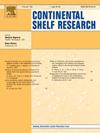A numerical investigation on the suspended sediment dynamics and sediment budget in the Mekong Delta
IF 2.2
3区 地球科学
Q2 OCEANOGRAPHY
引用次数: 0
Abstract
Fluvial sediment supply towards the coast has been the subject of extensive research. Important aspects relate to the impact of sediment retaining hydropower dams, potential delta progradation, coastal sediment supply and delta vulnerability to sea level rise. Once validated, process-based models provide a valuable tool to address these aspects and offer detailed information on sediment pathways, distribution and budget in specific systems.
This study aims to advance the understanding of the sediment dynamics and sediment budget in the Mekong Delta system. We developed a process-based model (Delft3D FM) that allows for coupling 2D area grids to 1D network grids. The flexible mesh describes both wide river sections and channel irrigation and drainage networks present in the Mekong Delta. We calibrated the model against observed discharge, salinity, suspended sediment concentration (SSC) and sediment flux.
The model was able to skillfully describe seasonal variations of SSC and hysteresis of SSC and water discharge caused by the Tonle Sap Lake induced flow patterns and seasonally varying bed sediment availability in the channels. Model results suggest that the Mekong River delivers an amount of sediment, towards the delta which is much lower than the common estimate of 160 Mt/year. About 23% of the modeled total sediment load at Kratie reaches the sea. Our modeling approach is a useful tool to assess sediment dynamics under strategic anthropogenic interventions or climate change scenarios.
湄公河三角洲悬沙动力与泥沙收支的数值研究
河流沉积物向海岸的供应一直是广泛研究的主题。重要的方面涉及挡沙水电站大坝的影响、潜在的三角洲淤积、沿海沉积物供应和三角洲对海平面上升的脆弱性。一旦得到验证,基于过程的模型将为解决这些问题提供有价值的工具,并提供有关特定系统中沉积物路径、分布和预算的详细信息。本研究旨在促进对湄公河三角洲泥沙动态和泥沙收支的认识。我们开发了一个基于过程的模型(Delft3D FM),允许将2D区域网格耦合到1D网络网格。灵活的网格描述了湄公河三角洲的宽河段和渠道灌溉和排水网络。我们根据观测到的流量、盐度、悬浮泥沙浓度(SSC)和泥沙通量对模型进行了校准。该模型能够很好地描述洞里萨湖诱导的流型和河床可利用性的季节变化所引起的SSC的季节变化以及SSC和水量的滞后性。模式结果表明,湄公河向三角洲输送的泥沙量远低于一般估计的1.6亿吨/年。在Kratie,模拟的总泥沙负荷中约有23%到达海洋。我们的建模方法是评估战略性人为干预或气候变化情景下沉积物动力学的有用工具。
本文章由计算机程序翻译,如有差异,请以英文原文为准。
求助全文
约1分钟内获得全文
求助全文
来源期刊

Continental Shelf Research
地学-海洋学
CiteScore
4.30
自引率
4.30%
发文量
136
审稿时长
6.1 months
期刊介绍:
Continental Shelf Research publishes articles dealing with the biological, chemical, geological and physical oceanography of the shallow marine environment, from coastal and estuarine waters out to the shelf break. The continental shelf is a critical environment within the land-ocean continuum, and many processes, functions and problems in the continental shelf are driven by terrestrial inputs transported through the rivers and estuaries to the coastal and continental shelf areas. Manuscripts that deal with these topics must make a clear link to the continental shelf. Examples of research areas include:
Physical sedimentology and geomorphology
Geochemistry of the coastal ocean (inorganic and organic)
Marine environment and anthropogenic effects
Interaction of physical dynamics with natural and manmade shoreline features
Benthic, phytoplankton and zooplankton ecology
Coastal water and sediment quality, and ecosystem health
Benthic-pelagic coupling (physical and biogeochemical)
Interactions between physical dynamics (waves, currents, mixing, etc.) and biogeochemical cycles
Estuarine, coastal and shelf sea modelling and process studies.
 求助内容:
求助内容: 应助结果提醒方式:
应助结果提醒方式:


